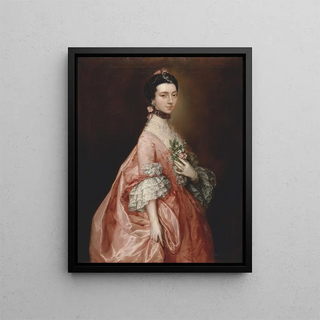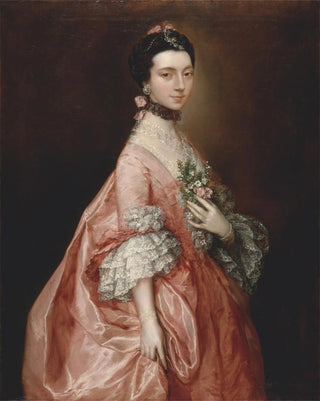Art print | Mary Little later Lady Carr - Thomas Gainsborough


View from behind

Frame (optional)
In the world of art, some works transcend their era to become timeless icons. The art print "Mary Little plus tard Lady Carr" by Thomas Gainsborough perfectly fits this category. Capturing the essence of a young woman with delicate beauty, this portrait is more than just a simple representation. It invites the viewer to immerse themselves in a universe where emotion and technique meet, revealing the subtleties of a time when art was both a reflection of society and a quest for aesthetic perfection. The art print of this masterpiece allows appreciation of Gainsborough's virtuosity, while offering a window into the past, a moment frozen in time.
Style and uniqueness of the artwork
Gainsborough's style is often characterized by his ability to blend realism and idealization. In "Mary Little plus tard Lady Carr," he manages to capture not only the physical features of his model but also a certain lightness and innate grace. The choice of colors, between soft and luminous tones, helps create an atmosphere that is both intimate and refined. The drapery of the dress, subtly crafted, seems almost to move with the breeze, while the blurred background highlights the main subject. This portrait, both personal and universal, evokes deep emotions, demonstrating a technical mastery that made Gainsborough famous. Every brushstroke seems to tell a story, that of a young woman at the dawn of her life, full of promises and dreams.
The artist and his influence
Thomas Gainsborough, born in 1727, is one of the most influential painters of the Rococo period and the early Neoclassicism. His innovative approach to portraiture profoundly impacted British art. By integrating elements of nature and landscapes into his works, Gainsborough established a dialogue between the human subject and their environment. His style, imbued with romanticism, inspired many artists, both contemporary and future. He knew how to give voice to human emotions, transforming the portrait into an art form capable of telling stories and capturing souls. Through "Mary Little plus tard Lady Carr," one

Matte finish

View from behind

Frame (optional)
In the world of art, some works transcend their era to become timeless icons. The art print "Mary Little plus tard Lady Carr" by Thomas Gainsborough perfectly fits this category. Capturing the essence of a young woman with delicate beauty, this portrait is more than just a simple representation. It invites the viewer to immerse themselves in a universe where emotion and technique meet, revealing the subtleties of a time when art was both a reflection of society and a quest for aesthetic perfection. The art print of this masterpiece allows appreciation of Gainsborough's virtuosity, while offering a window into the past, a moment frozen in time.
Style and uniqueness of the artwork
Gainsborough's style is often characterized by his ability to blend realism and idealization. In "Mary Little plus tard Lady Carr," he manages to capture not only the physical features of his model but also a certain lightness and innate grace. The choice of colors, between soft and luminous tones, helps create an atmosphere that is both intimate and refined. The drapery of the dress, subtly crafted, seems almost to move with the breeze, while the blurred background highlights the main subject. This portrait, both personal and universal, evokes deep emotions, demonstrating a technical mastery that made Gainsborough famous. Every brushstroke seems to tell a story, that of a young woman at the dawn of her life, full of promises and dreams.
The artist and his influence
Thomas Gainsborough, born in 1727, is one of the most influential painters of the Rococo period and the early Neoclassicism. His innovative approach to portraiture profoundly impacted British art. By integrating elements of nature and landscapes into his works, Gainsborough established a dialogue between the human subject and their environment. His style, imbued with romanticism, inspired many artists, both contemporary and future. He knew how to give voice to human emotions, transforming the portrait into an art form capable of telling stories and capturing souls. Through "Mary Little plus tard Lady Carr," one






